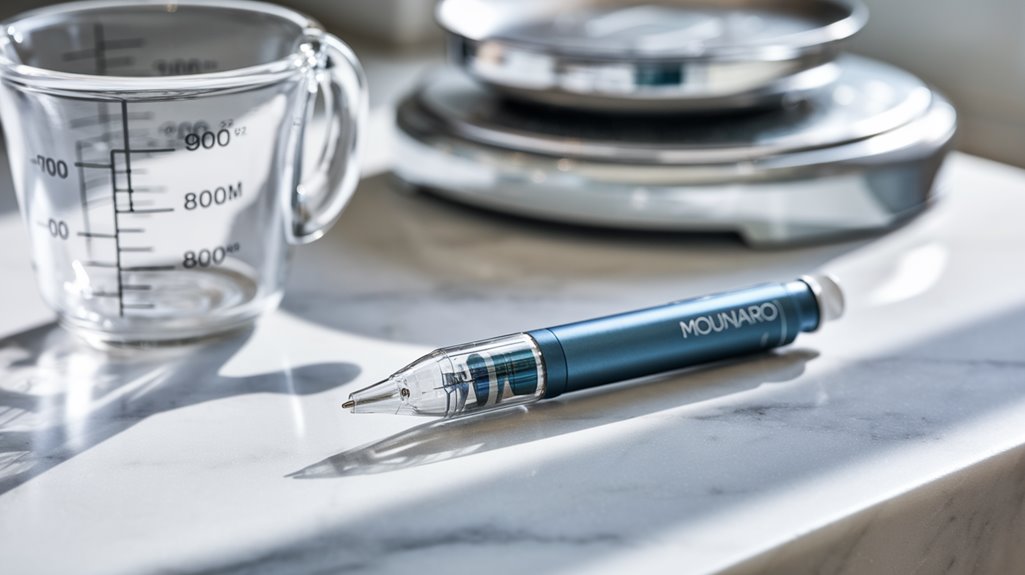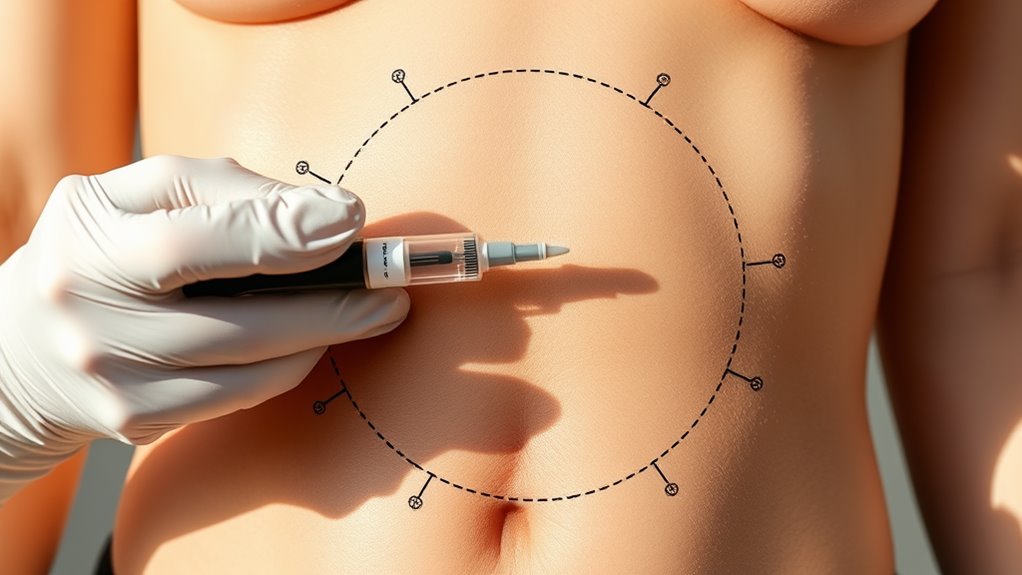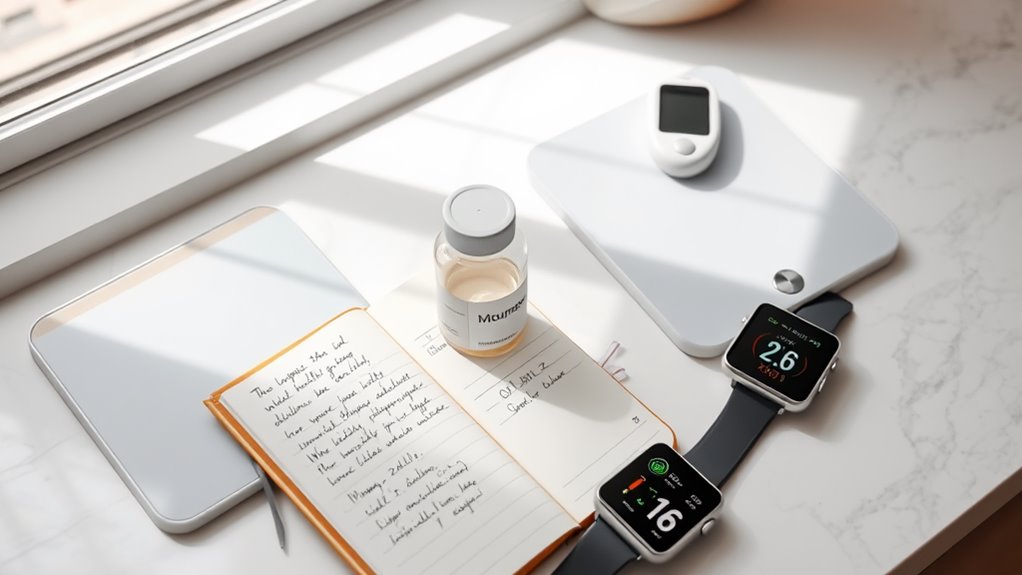Begin your Mounjaro journey with proper dosing guidelines, from initial 2.5mg injections through careful increases to achieve optimal results.

You'll start Mounjaro with a 2.5 mg weekly injection for the first four weeks, following a structured titration schedule. Your healthcare provider will guide dose increases in 2.5 mg increments every four weeks based on your therapeutic response and tolerability, up to a maximum of 15 mg weekly. Maintain at least 72 hours between doses, and inject subcutaneously in approved sites like the abdomen, thigh, or upper arm. Understanding proper administration techniques and monitoring protocols guarantees ideal treatment outcomes.
When initiating treatment with Mounjaro, patients must begin with a fixed starting dose of 2.5 mg administered once weekly for the first four weeks. This standardized protocol applies universally, regardless of your previous experience with weight loss medications or current health status. You'll maintain this initial dosage to allow your body to acclimate to the medication's pharmacological effects.
The 2.5 mg starting dose serves multiple clinical purposes. You should administer injections in the upper legs or abdomen for best results. It minimizes potential adverse reactions while establishing therapeutic efficacy through controlled exposure to the medication's active components. You shouldn't attempt to accelerate this process by skipping doses or increasing the amount without medical supervision, as this could compromise your safety and treatment outcomes.
Under your healthcare provider's guidance, dose adjustments may occur after the initial four-week period, based on your individual response and glycemic control needs. The maximum weekly dose you can progress to is 15 mg.
When you begin your Mounjaro treatment, you'll start with 2.5 mg weekly injections for four weeks before progressing to higher doses. Your healthcare provider will systematically increase your dosage by 2.5 mg increments every four weeks, based on your glycemic response and weight loss goals, until reaching the ideal therapeutic dose up to 15 mg weekly. If you miss a scheduled dose, you can administer the injection within a 4-day window of your regular dosing day, then resume your original weekly schedule. This gradual increase in medication strength helps minimize side effects while ensuring the treatment remains effective.
Starting Mounjaro treatment follows a carefully structured protocol designed to enhance therapeutic outcomes while minimizing adverse effects. You'll begin with a 2.5 mg weekly dose administered via a pre-filled injectable pen, maintaining this dosage for the initial four-week period. It's crucial to select your injection site from approved locations: abdomen, upper legs, or upper arms (with assistance), rotating sites weekly to prevent tissue irritation. If you miss a scheduled dose, you have a 4-day window to administer it before skipping and resuming your regular schedule.
Your healthcare provider will evaluate your response after the initial phase to determine appropriate dose adjustments. The standard progression allows for incremental increases every four weeks, potentially reaching a maximum maintenance dose of 15 mg weekly. You'll need to maintain consistent weekly timing for your injections, administering them on the same day and time to guarantee optimal therapeutic levels.
The systematic progression of Mounjaro dosage follows a precise four-week titration schedule designed to enhance therapeutic efficacy. You'll begin with 2.5 mg weekly for the initial four weeks, followed by incremental 2.5 mg increases at four-week intervals until reaching your maintenance dose. Your healthcare provider will evaluate your response and adjust accordingly. Each pen provides four weekly doses to complete one month of treatment.
| Time Period | Weekly Dose | Clinical Assessment |
|---|---|---|
| Weeks 1-4 | 2.5 mg | Initial tolerance |
| Weeks 5-8 | 5.0 mg | Response evaluation |
| Weeks 9-12 | 7.5 mg | Efficacy monitoring |
| Weeks 13-16 | 10.0 mg | Side effect review |
| Weeks 17+ | 12.5-15.0 mg | Long-term maintenance |
Your individualized titration may vary based on therapeutic response and tolerability factors. The maximum recommended dose is 15 mg weekly, though lower maintenance doses may be prescribed if you achieve favorable results or experience significant side effects.
Proper management of missed Mounjaro doses requires adherence to specific time-based protocols to maintain therapeutic effectiveness. If you've missed a dose, you can take it within 96 hours of the scheduled time. However, if more than 4 days have elapsed, skip the missed dose and resume your regular schedule.
Each Mounjaro pen comes with four weekly doses to help maintain a consistent monthly treatment schedule. It's essential to maintain at least 72 hours between doses to guarantee proper medication levels. Don't compensate for missed doses by taking double amounts, as this can trigger adverse effects. If you need to change your weekly dosing day, make sure there's a minimum 3-day interval between injections.
To optimize adherence, set consistent reminders and administer your dose at the same time weekly. This methodical approach helps maintain steady therapeutic levels and minimizes potential complications from irregular dosing patterns.

Selecting an appropriate injection site marks the first critical step in administering Mounjaro effectively. You'll need to choose between three primary subcutaneous injection locations: the abdomen (2 inches from the navel), thigh, or upper arm. While all sites offer similar absorption rates, your selection should prioritize accessibility and comfort. For cost-effective treatment, consider that prescription savings tools are available exclusively within the United States.
When preparing for injection, follow these essential protocols:
Insert the needle at an angle and maintain position for 5 seconds after plunger depression to ascertain complete dose delivery. You'll need to rotate injection sites weekly to prevent tissue complications. Always use new needles and syringes, disposing of used materials in an approved sharps container. If bleeding occurs, apply gentle pressure with sterile gauze without rubbing the area.
Following correct injection technique, adherence to a consistent dosing schedule becomes the next key factor in Mounjaro's therapeutic success. When managing missed doses, you'll need to follow specific timing protocols to maintain the medication's efficacy.
If you've missed a dose within 4 days, administer it immediately and resume your regular schedule. However, if more than 4 days have elapsed, skip the missed dose and wait for your next scheduled injection. Never attempt to compensate by taking two doses within a 72-hour period.
To alter your regular dosing day, guarantee a minimum 72-hour interval from your last injection before shifting to the new schedule. For instance, when moving from Monday to Thursday, maintain the prescribed separation period. Update your reminder systems accordingly to prevent future missed doses. Remember that consistent timing optimizes Mounjaro's therapeutic benefits while minimizing potential adverse effects. Always dispose of used Mounjaro pens in a sharps disposal container for safety.

While initiating Mounjaro therapy, systematic monitoring of both therapeutic progress and potential adverse effects becomes crucial for ideal outcomes. You'll need regular clinical assessments to evaluate treatment response and adjust dosages accordingly. Your healthcare provider will conduct blood tests to monitor kidney function and screen for early signs of complications like pancreatitis. Patients often need to ensure proper injection site rotation to minimize localized reactions and discomfort.
To optimize therapeutic efficacy while minimizing adverse effects, you'll need to implement specific dietary modifications. These include consuming smaller portions, avoiding high-fat foods, and maintaining adequate hydration. Regular communication with your healthcare provider guarantees proper dose titration and management of any emerging side effects, ultimately supporting your treatment objectives while maintaining safety parameters.
You'll need to establish a consistent blood glucose monitoring schedule to track Mounjaro's effectiveness and detect any abnormal fluctuations. Your healthcare provider will guide you through a structured dose titration schedule, typically starting at 2.5 mg and incrementally increasing to the target maintenance dose based on your glycemic response and tolerability. Regular monitoring of both fasting and postprandial glucose levels will help determine if dosage adjustments are necessary while maintaining ideal glycemic control. Maintaining proper diet and exercise alongside medication use can significantly enhance the effectiveness of GLP-1 agonist treatment.
Regular blood sugar monitoring serves as a cornerstone of safe and effective Mounjaro treatment. You'll need to establish baseline measurements through fasting glucose levels and HbA1c testing before initiating therapy. Continuous glucose monitoring systems (CGMS) provide real-time data, enabling precise treatment adjustments and early detection of glycemic variations. Digital health applications and telemedicine platforms allow for data aggregation analysis to optimize treatment outcomes.
Key monitoring components include:
Your healthcare provider will utilize CGMS data to enhance your treatment protocol, making necessary dosage adjustments based on your glycemic response. This systematic monitoring approach helps prevent complications while ensuring favorable therapeutic outcomes with Mounjaro.
Successful implementation of Mounjaro therapy requires a carefully structured dosage titration schedule that begins with 2.5mg weekly injections for the first four weeks. You'll increase your dose by 2.5mg increments every four weeks, progressing through 5mg, 7.5mg, 10mg, and 12.5mg doses, up to a maximum of 15mg weekly.
Your healthcare provider will monitor your clinical response and adjust your dosage based on tolerability. Regular blood tests and health check-ups are essential to manage potential side effects. If you experience persistent side effects, particularly signs of pancreatitis or kidney dysfunction, your provider may modify your dosage. It's vital not to exceed the 15mg weekly maximum dose, as this could increase your risk of adverse effects. Maintain open communication with your healthcare team about any concerns during the titration process. Common side effects like digestive issues may persist throughout treatment, so discussing management strategies with your doctor is important.

Maintaining an effective treatment regimen with Mounjaro requires consistent collaboration with your healthcare provider through regular consultations and monitoring. Your licensed practitioner will conduct thorough evaluations, order necessary blood work, and adjust your dosage based on your individual response and tolerability. Regular monitoring includes HbA1c tests to assess long-term blood sugar control.
Your healthcare team may include various specialists, such as endocrinologists and diabetes educators, who'll provide additional expertise. They'll implement a personalized titration schedule, typically increasing doses by 2.5mg every four weeks. Adherence to their prescribed instructions is essential for optimizing treatment outcomes and ensuring your safety. Through ongoing clinical oversight, your provider can make evidence-based adjustments to your treatment plan while managing any emerging concerns.
You shouldn't combine Mounjaro with other weight loss medications, especially phentermine, as this can cause adverse reactions including headaches, dizziness, and hypoglycemia. Consult your healthcare provider for guidance.
Store your Mounjaro pens in the refrigerator at 36-46°F (2-8°C). You can keep them at room temperature up to 86°F (30°C) for 21 days. Protect from light and don't freeze.
Yes, Mounjaro's delayed gastric emptying can reduce your birth control pill's effectiveness. Your risk is highest in the first 4 weeks. You'll need backup contraception like condoms or consider switching to non-oral birth control methods.
While you can drink moderately with Mounjaro, it's best to limit alcohol consumption as it may increase hypoglycemia risk, worsen side effects, and reduce the medication's effectiveness in managing blood sugar.
You'll need to stop Mounjaro immediately and contact your doctor. The drug's safety during pregnancy isn't established, and animal studies suggest potential fetal risks. Switch to safer alternatives like insulin.
Following Mounjaro's dosing protocol precisely optimizes your glycemic control and weight management outcomes. Clinical data demonstrates that patients who maintain consistent weekly administration achieve superior HbA1c reductions. Consider Patient X, who achieved a 2.1% reduction in HbA1c over 40 weeks through methodical dose escalation from 2.5mg to 15mg, adhering to the prescribed titration schedule. Consult your healthcare provider for individualized dosing adjustments based on your metabolic response and tolerability profile.